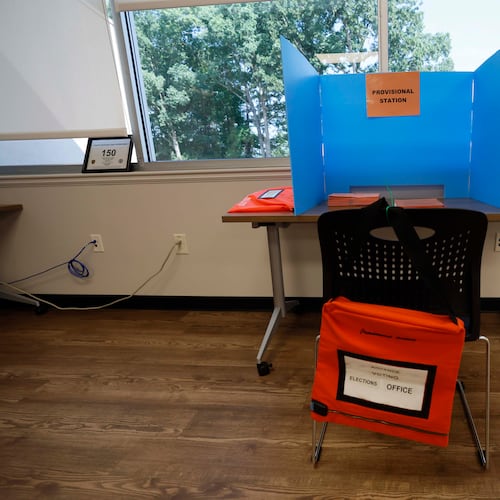Big jobs
A new law signed Thursday allows the state to focus more money on fewer locations to get big projects done faster. No final decisions have been made, but these interchange projects are some of the candidates, according to the state transportation planning director:
- Ga.400/I-285
- Other I-285 interchanges including both at I-20
- I-16/I-75 in Macon
- Ga. 21/I-95 in Savannah
A massive rebuild for the congested interchange at Ga. 400 and I-285 and other key projects across the state may finally have a solid funding plan in sight thanks to a law signed Thursday by Gov. Nathan Deal.
It just won’t be quick or easy.
With a stroke of Deal’s pen, financial handcuffs loosened on the state Department of Transportation. The new law, passed as part of House Bill 202, exempts interstate highways and freight corridors from an old state requirement that DOT allocate much of its federal highway money based on congressional districts rather than to the biggest transportation priorities.
That means those hugely expensive widening projects now have the state’s entire checkbook to draw from, rather than 1/14 of it, if that’s where policymakers decide the money should go. The state’s transportation planning director, Toby Carr, said Thursday that interchanges on I-285, such as the one at Ga. 400, and a project at I-75 and I-16 in Macon are some of the likely candidates for refocusing money.
Unfortunately, even that big statewide checkbook isn’t big enough for a quick fix. The projects still must be broken into pieces that can be completed over several years.
In addition, to make those projects happen sooner, other projects somewhere in the state still would have to be canceled or postponed. State officials said Thursday that they have not yet made those choices.
The change is part and parcel of transportation planning in Deal’s post-T-SPLOST Georgia. The rejection of that proposed one percent sales tax in referendums across most of the state, Congress’s failure to deal with a weakening federal gas tax, and possible federal cuts to airports have left a bleak outlook for transportation funding.
With no plan to raise new infrastructure dollars in the works, state leaders and Deal in particular have instead resorted to less sweeping changes — but changes they hope are focused enough to have some impact on unclogging metro Atlanta’s roads.
The two legislative changes Deal signed into law Thursday are designed to give the state more flexibility over infrastructure spending as policymakers try to ease congestion, recruit more business and accommodate the Savannah port’s growth without a new source of revenue.
Yet even as Deal signed them in front of prominent Atlanta business leaders who pumped time and treasure into Atlanta’s T-SPLOST referendum, the governor warned that we have only begun to realize the impact of the tax’s defeat and $85 billion in mandatory across-the-board federal budget cuts.
“Most of the state doesn’t have the extra one-cent sales tax, which means less money,” Deal told the Metro Atlanta Chamber’s leaders. “What are you going to do? What common sense dictates: Make the best use of the money you already have.”
After a sweeping reorganization of transportation law passed power from the DOT board to the governor in 2009, changes like the one signed Thursday mean even more power over the state’s transportation choices fall into Deal’s lap. That gives Deal’s office a greater degree of control over the state’s infrastructure levers, but also more risk if the policies don’t bring about positive changes.
After the T-SPLOST lost, Deal specifically mentioned the Ga. 400/I-285 project as one he would try to focus on, but the question was how. It is written into budget books as part of a much larger dream for northern I-285, not to be funded until after 2030 at the soonest.
Carr, the planning director, who reports to Deal, said I-285 interchanges and the one in Macon show how inefficient the old policy was, since people from all over the state, and the nation, use interstates. When congressional redistricting moved the Macon interchange from one district to another, that blew up the transportation budget for its new district.
DOT has yearned for the flexibility for several years as rural legislators blocked it, fearing they would lose money to Atlanta. But suddenly this year, the Legislature was on board.
Jay Shaw, a DOT board member who was a rural legislator, said the turnabout made sense. “We realize that the economic engine of the state is Atlanta,” he said, noting that his own rural district had gotten more money than an Atlanta district.
The T-SPLOST’s failure had legislative impact, too, said the sponsor of HB 202, State Rep. Bubber Epps, R-Dry Branch. “I think the fact that it didn’t achieve its purpose brought attention to the fact that our options are limited,” and the state must make the most of them, Epps said.
A second bill Deal signed, Senate Bill 70,would give DOT more leeway in contracting out projects where it wants to combine the design and construction into one job. Deal hopes it will spur more innovation and drive down costs.
They emerged in a legislative session otherwise devoid of debate about the promised “Plan B” for infrastructure funding. Lawmakers and advocates who had campaigned against the T-SPLOST with vows of a better alternative failed to build political support for any, leaving the tax’s most ardent champions hoping the tweaks would help.
“The governor is trying to build infrastructure creatively,” said Sam Williams, president of the Metro Atlanta Chamber, which raised millions to promote the $7.2 billion regional transportation sales tax. “And I think we’re going to see more projects like this.”
Meanwhile, huge infrastructure challenges sure to test Georgia’s treasury await. None are more important to Deal than the $652 million project to deepen 38 miles of the Savannah River and harbor to make way for bigger cargo ships.
Wednesday’s announcement that Georgia will pay $33.5 million to settle a lawsuit over the project was a reminder that those costs can quickly balloon. There could be more to come, as Deal said he’s considering whether the state will add to the $231 million it’s already pumped into the project in the absence of more federal help.
“We’re going to be doing everything we can, and some of the things we do to achieve that may be perceived as expensive,” he said. “But they are necessary.”
About the Author
Keep Reading
The Latest
Featured



